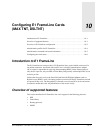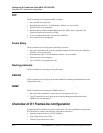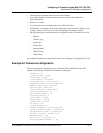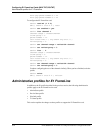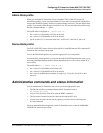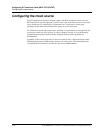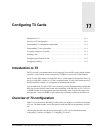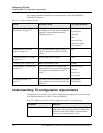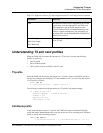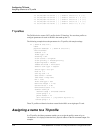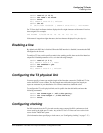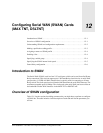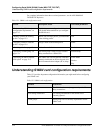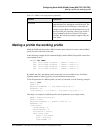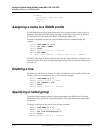
Configuring T3 Cards
Understanding T3 slot card profiles
APX 8000/MAX TNT/DSLTNT Physical Interface Configuration Guide Preliminary May 9, 2000 11-3
Understanding T3 slot card profiles
When the TAOS unit first detects the presence of a T3 slot card, it creates the following
profiles for each card:
• One T3 profile
• One Call-Route profile
• 28 T1 profiles (one for each DS1 on the T3 card)
T3 profile
When the TAOS unit first detects the presence of a T3 card, it creates a default T3 profile for
the card. For example, after installing a T3 card installed in slot 7, you can verify the creation
of a T3 profile as follows:
admin> dir t3
7 03/21/1997 21:12:03 { shelf-1 slot-7 0 }
The following example shows the parameters in a T3 profile, with sample settings:
t3 { shelf-N slot-N N }
physical-address* = { shelf-N slot-N N }
enabled = yes
application = m13
line-length = 1-255
Call-Route profile
At the same time that it creates a T3 profile, the TAOS unit creates one default Call-Route
profile that routes outbound trunk calls to any line on the card. You can display the Call-Route
profile as shown in the following example:
admin> dir call-r
9 02/28/1997 10:54:38 { { { any-shelf any-slot 0 } 0 } 0 }
FDL The DS1-level FDL services supported by the T3 card
are the same as for the eight-port T1 card. DS3-level
FDL capabilities such as the Far-End Alarm and
Control Channel (FEAC) and Path Maintenance Data
Link are currently unsupported. (For information on
specifying FDL, see the APX 8000/MAX TNT/DSLTNT
Adminstration Guide.)
Front-End-Type
DSX-Line-Length
CSU-Build-Out
These parameters are ignored in T1 profiles that apply
to the T3 card.
Table 11-2. Differences between T3 card configuration and T1 card configuration (continued)
Parameter Difference



